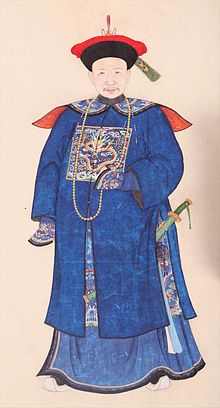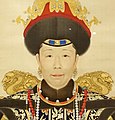
The Daoguang Emperor, also known by his temple name Emperor Xuanzong of Qing, personal name Mianning, was the seventh emperor of the Qing dynasty, and the sixth Qing emperor to rule over China proper. His reign was marked by "external disaster and internal rebellion". These include the First Opium War and the beginning of the Taiping Rebellion which nearly brought down the dynasty. The historian Jonathan Spence characterizes the Daoguang Emperor as a "well meaning but ineffective man" who promoted officials who "presented a purist view even if they had nothing to say about the domestic and foreign problems surrounding the dynasty".

The Jiaqing Emperor, also known by his temple name Emperor Renzong of Qing, personal name Yongyan, was the sixth emperor of the Qing dynasty and the fifth Qing emperor to rule over China proper. He was the 15th son of the Qianlong Emperor. During his reign, he prosecuted Heshen, the corrupt favorite of his father and attempted to restore order within the empire while curbing the smuggling of opium into China. Assessments of his reign are mixed, either seen as the "beginning of the end" of the Qing dynasty, or as a period of moderate reform that presaged the intellectual movements of the 1860s.

Ebilun was a Manchu noble and warrior of the Niohuru clan, most famous for being one of the Four Regents assisting the young Kangxi Emperor from 1661 to 1667, during the early Qing dynasty (1644–1912). A largely passive figure during the regency, Ebilun was disgraced following the ouster of the far more powerful regent Oboi and considered a political supporter of the latter. He was stripped of his positions by the emperor but later regained his noble rank. Many of his descendants became influential figures in the Qing imperial government.
Gūwalgiya was one of the most powerful Manchu clans. It is often listed by historians as the first of the eight prominent Manchu clans of the Qing dynasty. After the demise of the dynasty, some of its descendants sinicized their clan name to the Han Chinese surname Guan (關).
Ajige was a Manchu prince and military general of the early Qing dynasty. He was born in the Aisin Gioro clan as the 12th son of Nurhaci, the khan of the Later Jin dynasty.

Empress Xiaoquancheng, of the Manchu Bordered Yellow Banner Niohuru clan, was a posthumous name bestowed on the wife and second empress consort of Mianning, the Daoguang Emperor. She was empress consort of Qing from 1834 until her death in 1840.
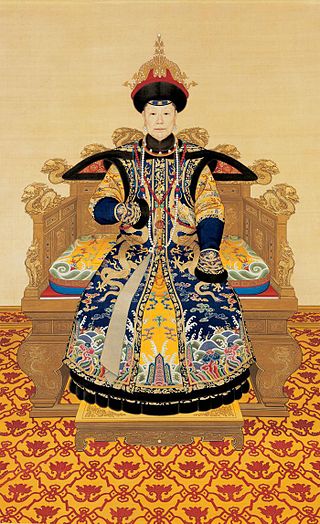
Empress Xiaoshengxian, of the Manchu Bordered Yellow Banner Niohuru clan, was a posthumous name bestowed to the consort of Yinzhen, the Yongzheng Emperor and mother of Hongli, the Qianlong Emperor. She was honoured as Empress Dowager Chongqing during the reign of her son and posthumously honoured as empress, although she never held the rank of empress consort during her lifetime.
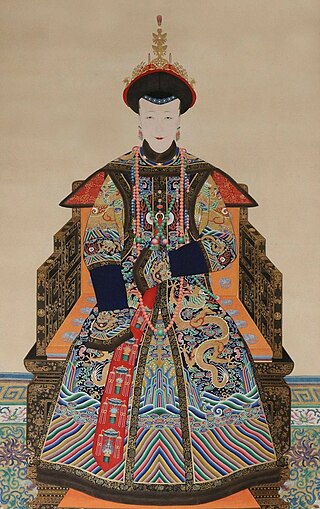
Imperial Noble Consort Gongshun (恭順皇貴妃) of the Manchu Bordered Yellow Banner Niohuru clan (鈕祜祿氏) was a consort of the Jiaqing Emperor. She was 27 years his junior.

Empress Xiaoherui, of the Manchu Bordered Yellow Banner Niohuru clan, was a posthumous name bestowed to the wife and second empress consort of Yongyan, the Jiaqing Emperor. She was empress consort of Qing from 1801 until her husband's death in 1820, after which she was honoured as Empress Dowager Gongci during the reign of her step-son, Mianning, the Daoguang Emperor. She was the longest-serving empress consort in Qing history.

Empress Xiaozhaoren, of the Manchu Bordered Yellow Banner Niohuru clan, was the second wife of the Kangxi Emperor. She was empress of China during the Qing dynasty from 1677 until her death in 1678.
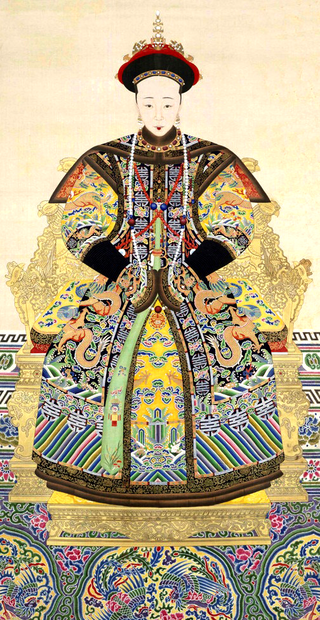
Empress Xiaomucheng, of the Manchu Bordered Yellow Banner Niohuru clan, was a consort of the Daoguang Emperor.

Noble Lady Shun, of the Manchu Niohuru clan, was a consort of the Qianlong Emperor of the Qing dynasty.

Nara is a clan name shared by a number of royal Manchu clans, sometimes also transliterated as Nalan or Nalland. The four tribes of the Hūlun confederation (扈倫四部) – Hada, Ula, Hoifa and Yehe – were all ruled by clans bearing this name.
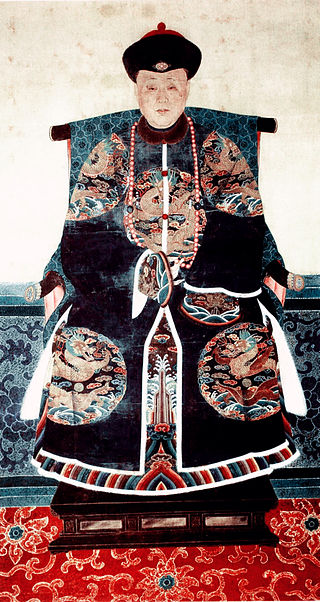
Princess Hexiao of the First Rank was a Manchu princess of the Qing dynasty. She was the tenth and youngest daughter of the Qianlong Emperor. Her mother was Consort Dun.
Eidu was a Manchu officer and a member of the Niohuru clan.

Yun'e, born Yin'e, was a Manchu prince of the Qing dynasty of China. He was a relatively unremarkable prince who was primarily known to be a crony of his older brother Yunsi.
Fuca was a clan of Manchu nobility. After the demise of the dynasty, some of its descendants sinicized their clan name to the Chinese surnames Fu (富/傅) or Li (李).
Noble Consort Wenxi, of the Manchu Bordered Yellow Banner Niohuru clan, was a consort of the Kangxi Emperor.
Concubine Cheng, of the Manchu Plain Red Banner Niohuru clan, was a consort of Qianlong Emperor.
Consort Yuan of the Bordered Yellow Banner Niohuru clan, was the wife of Hong Taiji. She was one year his junior. Later literatures have regarded her as Hong Taiji's first wife and primary consort.
